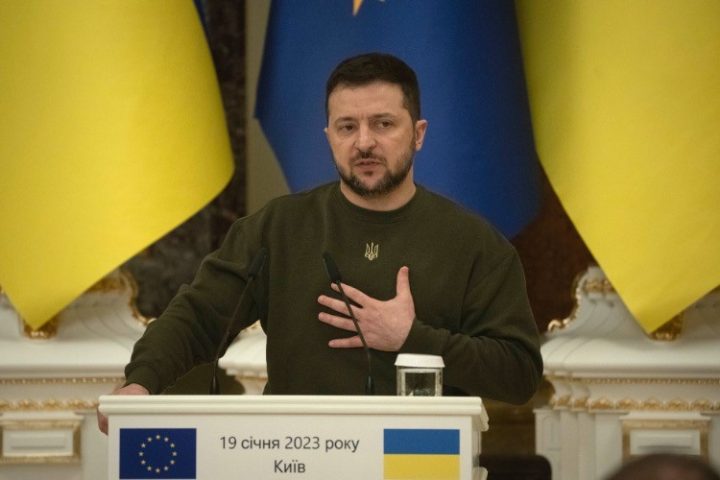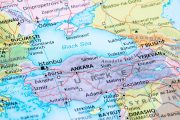
Ukraine needs new weapons and faster deliveries to tackle a “very tough” situation, as it faces constant assaults by Russian forces in the eastern Donetsk region, President Volodymyr Zelensky claimed on January 29.
“The situation is very tough. Bakhmut, Vuhledar and other sectors in the Donetsk region — there are constant Russian attacks. There are constant attempts to break through our defenses,” Zelensky declared in his nightly video address in his latest call for increased weapons shipments days after Germany and the United States led a group of countries agreeing to provide modern tanks.
“Russia wants the war to drag on and exhaust our forces. So we have to make time our weapon. We have to speed up events, speed up supplies and open up new weapons options for Ukraine.”
Moreover, the General Staff of Ukraine’s armed forces said previously that its forces fought off an attack near Blahodatne in the eastern part of the Donetsk region, while Russia’s Wagner private military group asserted it took control of the village.
However, a subsequent military statement failed to include Blahodatne in the details.
On Saturday, Zelensky also said Ukraine needed the U.S.-made ATACMS missile with a range of about 300 km, which Washington has so far refused to provide. A presidential advisor said discussions were ongoing on offering long-range missiles. Furthermore, a Ukrainian air force spokesman mentioned that talks were underway on supplying aircraft.
Zelensky’s latest Ukraine command was keen on reiterating that “our pressure is greater than the occupiers’ capacity to attack” and that meant “maintaining the defense support from our partners.”
“The enemy takes no account of its personnel and despite the extent of the losses is maintaining the intensity of its attacks,” he said.
“Confronting this requires extraordinary resilience and a full awareness by our soldiers that in defending Donetsk region they are defending all of Ukraine.”
Zelensky advisor Mykhailo Podolyak, an advocate for western warplanes, has also participated in talks with Western nations. He claimed that if Ukraine obtained the advanced weaponry, it would “reduce fatalities … reduce security threats to the European continent, this will keep the war localized.” In a nod to Zelensky, Podolyak lampooned some unnamed allied nations as being “conservative” in their approach in deploying military aid because they did not wish for “changes in the international architecture.”
War-torn Ukraine’s shopping spree does not end here. Deputy Foreign Minister Andrij Melnyk previously made headlines when he immediately asked for fighter jets after inking an agreement for tanks. Now, Melnyk is reported to be exploring naval options.
Meanwhile, German Chancellor Olaf Scholz reiterated on Sunday that Germany will not send fighter jets to Ukraine.
Scholz only just agreed last Wednesday to send 14 Leopard 2 tanks to Ukraine and to permit other European countries to send theirs, after weeks of heated discussions and rising pressure from allies.
“I can only advise against entering into a constant bidding war when it comes to weapons systems,” Scholz stated in an interview with the Tagesspiegel newspaper.
“If, as soon as a decision [on tanks] has been made, the next debate starts in Germany, that doesn’t come across as serious and undermines citizens’ confidence in government decisions.”
Scholz’s approval to send the tanks was followed by a U.S. declaration that it would send 31 of its Abrams tanks.
In turn, Zelensky expressed his gratitude to Berlin and Washington for the move, regarded as a significant step to back Ukraine. Nonetheless, he instantly added that Ukraine would require more heavy weapons from NATO allies to repel Russian troops — weapons such as fighter jets and long-range missiles.
Scholz in the interview cautioned against ramping up “the risk of escalation” amid Moscow’s denunciation of the tank pledges.
“There is no war between NATO and Russia. We will not allow such an escalation,” he said.
The chancellor elaborated that it is “necessary” to hold discussions with Russian President Vladimir Putin. The most recent phone call between the leaders was in early December.
“I will talk to Putin by phone again,” Scholz said.
“But of course it’s also clear that as long as Russia continues to wage war with unabated aggression, the current situation will not change.”
Earlier, the U.S. and European governments were faced with the uncertainty of whether Scholz could be convinced to send some of his country’s tanks to support Ukraine in the war.
When defense officials from 50 of Ukraine’s allied states assembled at a U.S. Air Force base in Germany to hear Scholz’s decision, they received a firm answer in the negative, accompanied by a vague “perhaps another time” remark.
U.S. Defense Secretary Lloyd Austin, who presided over the meeting, seemed frustrated at Scholz’s verdict. “We could all do more” to arm Ukraine, he told journalists.
Other leaders were more forthcoming. “Almost a year has passed since the outbreak of war…. Evidence of the Russian army’s war crimes can be seen on television and on YouTube. What more does Germany need to open its eyes and start to act in line with the potential of the German state?” Polish Prime Minister Mateusz Morawiecki furiously asked after the end of the meeting.
“I try to weigh my words, but I’ll say it bluntly. Ukraine and Europe will win this war with or without Germany,” Morawiecki continued, stating that it was up to the Germans whether they wanted to “join the mission of halting Russian barbarity” or persist in witnessing the conflict passively, “condemning themselves to be on the wrong side of history.”
Discussions about the delivery of tanks to Ukraine has been one of the most vital moves since the conflict started last February. Proponents of backing Ukraine militarily contend that Putin is launching a war of attrition in which Ukraine is to be bombed and destroyed slowly but systematically. These proponents presume that if no action is taken, Western nations would eventually grow sick of backing Ukraine, eventually letting the country fall under Russia’s orbit.
Supplying Ukraine with tanks would empower Ukraine to fend off Russian moves, according to these proponents. Moreover, they argue that such help needs to be done rapidly, partly because milder weather over the next two months would facilitate a ground offensive. To boot, an estimated 200,000 additional Russian troops rallied by the partial mobilization Putin ordered last September will soon be battle-ready.
Thus, German Foreign Minister Annalena Baerbock hinted that the country would not “stand in the way” if Poland decided to dispatch its Leopard tanks to the Ukrainians. Additionally, Der Spiegel, Germany’s top weekly news magazine, disclosed that the German military secretly singled out at least 19 Leopard 2 tanks that could be sent to Ukraine as far back as August 2022.
Following the end of the Cold War, the militaries of Britain and France have run down their stocks of tanks and armored personnel carriers; until the Ukraine war erupted, the common understanding among military strategists in both countries was that future wars would be expeditionary operations fought in distant places for short periods of time and by highly mobile forces, instead of widespread tank battles on the European continent. Therefore, media reports reveal that Britain and France have a maximum of 180 operational tanks each, with not many more in reserve.
While French President Emmanuel Macron hitherto portrayed his country’s AMX-10 vehicles presently delivered to Ukraine as “light battle tanks,” critics have contended that they are merely armored personnel carriers in reality. Similarly, although Britain has declared that it is sending Challenger 2 tanks to Ukraine, only 14 will be transferred, with all operating on obsolete technology.
What is more, the British tanks need two sets of tools for maintenance: one set for the turret, which is in metric sizes, and the other for the tank’s hull, still designed in old imperial measurements. Notably, the ammunition for the Challenger 2 is rare in Europe.
In contrast, Germany has almost as many tanks as Britain and France combined. Germany’s Leopard 2 tank is also a groundbreaking high precision platform, far easier to maintain and fitted with a 120mm gun, standard among Western militaries. An additional 2,000 Leopard 2 tanks are housed in a dozen other European states.
A thorn in the flesh regarding the matter of sending Western tanks to the front lines of the Ukraine conflict would be the risk of classified Western technology landing in Russian hands. Although this matter has not been discussed in the open, it likely was in the back of the minds of Western leaders and lawmakers as they deliberated Ukraine’s demand for tanks.
For example, concerns abound that the Russians could obtain the classified Chobham armor of the British Challenger 2s, or the unique multi-layered armor, advanced optics, and sight systems of the Leopards and Abrams, which purportedly give them an edge over their Russian counterparts.
After all, tanks have a track record of being ditched after experiencing mechanical problems and battle damage, making them immobile though generally intact. As abandoned tanks in the past have been seized by enemy forces during the Gulf War in the 1990s and the counter-ISIS campaign in Iraq and Syria in the mid-2010s, observers fear that the same may occur in Ukraine. Should such a situation happen, many worry that the Russians could examine these military platforms to investigate their secrets, plan countermeasures by pointing out flaws, or even replicate them.
The risk of arms capture runs both ways. Various pieces of more advanced Russian arms, like the short-range Tor surface-to-air missile system and electronic warfare equipment, have also been seized from the Russians after their retreats from Kyiv, Kherson, and Kharkiv by pro-Ukraine forces.
In the interim, the Russians have been displeased with Western support for Ukraine.
Washington is mainly profiting from the Ukraine conflict, especially from European countries’ weapon supplies to Kyiv, Russian Deputy Foreign Minister Sergey Ryabkov told Sputnik News:
It is obvious that the United States is not only the main conductor in the Ukraine crisis but also its main beneficiary. Among other things, Washington considers Ukraine as a testing ground for its military-industrial products, where various weapons systems and methods of their use, including modern, very long-range ones, are being tested… for resistance to Russian weapons.
Elaborating, he said that by withdrawing military equipment from Europe, sending it “for disposal” to Ukraine, Washington plans to enforce on Europeans new, multibillion-dollar contracts to buy U.S. military equipment. This “cynical game” “will end badly” for those involved, Ryabkov said ominously.



